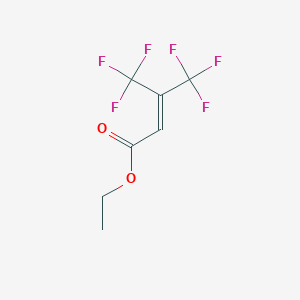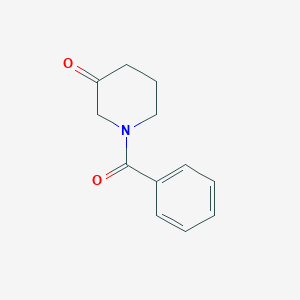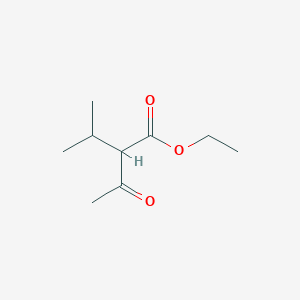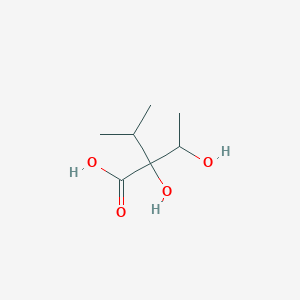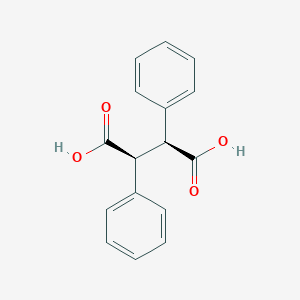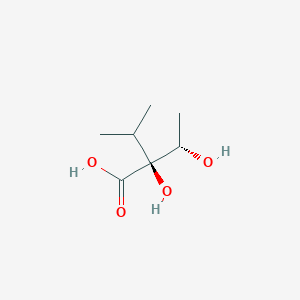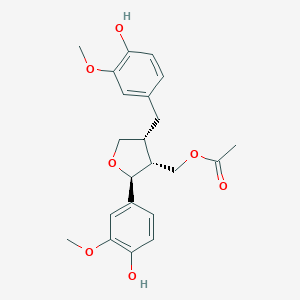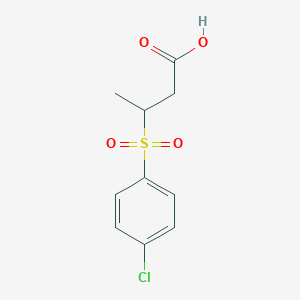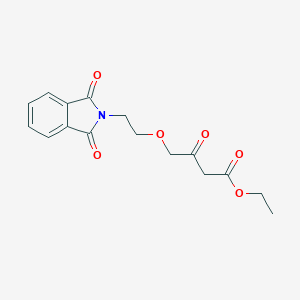
4-(2-(1,3-dioxoisoindolin-2-yl)éthoxy)-3-oxobutanoate d’éthyle
Vue d'ensemble
Description
Ethyl 4-(2-(1,3-dioxoisoindolin-2-yl)ethoxy)-3-oxobutanoate is a complex organic compound characterized by the presence of an isoindoline-1,3-dione moiety
Applications De Recherche Scientifique
Ethyl 4-(2-(1,3-dioxoisoindolin-2-yl)ethoxy)-3-oxobutanoate has a wide range of scientific research applications:
Mécanisme D'action
Target of Action
Ethyl 4-(2-(1,3-dioxoisoindolin-2-yl)ethoxy)-3-oxobutanoate is a derivative of indole . Indole derivatives have been found to bind with high affinity to multiple receptors , which suggests that this compound may also interact with a variety of targets.
Mode of Action
Given its structural similarity to other indole derivatives, it may interact with its targets in a similar manner .
Biochemical Pathways
Indole derivatives have been found to possess various biological activities, including antiviral, anti-inflammatory, anticancer, anti-hiv, antioxidant, antimicrobial, antitubercular, antidiabetic, antimalarial, and anticholinesterase activities . This suggests that this compound may affect a variety of biochemical pathways.
Result of Action
Given the broad spectrum of biological activities associated with indole derivatives , this compound may have a variety of effects at the molecular and cellular level.
Méthodes De Préparation
Synthetic Routes and Reaction Conditions
The synthesis of Ethyl 4-(2-(1,3-dioxoisoindolin-2-yl)ethoxy)-3-oxobutanoate typically involves the condensation of an aromatic primary amine with a maleic anhydride derivative, leading to the formation of the isoindoline-1,3-dione scaffold . Another approach involves the reaction of phthalic anhydride with glycine and acetic acid in the presence of triethylamine in toluene as a solvent .
Industrial Production Methods
Industrial production methods for this compound are not extensively documented, but they likely involve similar synthetic routes with optimization for large-scale production. This includes the use of efficient catalysts and solvent systems to maximize yield and purity.
Analyse Des Réactions Chimiques
Types of Reactions
Ethyl 4-(2-(1,3-dioxoisoindolin-2-yl)ethoxy)-3-oxobutanoate undergoes various types of chemical reactions, including:
Oxidation: This compound can be oxidized to introduce additional functional groups.
Reduction: Reduction reactions can modify the isoindoline-1,3-dione moiety.
Substitution: Electrophilic and nucleophilic substitution reactions can occur at various positions on the molecule.
Common Reagents and Conditions
Common reagents used in these reactions include oxidizing agents like potassium permanganate, reducing agents such as lithium aluminum hydride, and various nucleophiles and electrophiles for substitution reactions .
Major Products
The major products formed from these reactions depend on the specific conditions and reagents used. For example, oxidation can lead to the formation of carboxylic acids, while reduction can yield amines or alcohols.
Comparaison Avec Des Composés Similaires
Similar Compounds
N-isoindoline-1,3-dione derivatives: These compounds share the isoindoline-1,3-dione core and exhibit similar chemical reactivity and biological activities.
Indole derivatives: Compounds containing the indole nucleus also show diverse biological activities and are used in similar applications.
Uniqueness
Ethyl 4-(2-(1,3-dioxoisoindolin-2-yl)ethoxy)-3-oxobutanoate is unique due to its specific structure, which combines the isoindoline-1,3-dione moiety with an ethoxy and oxobutanoate group. This unique combination of functional groups imparts distinct chemical and biological properties, making it a valuable compound for various research and industrial applications .
Propriétés
IUPAC Name |
ethyl 4-[2-(1,3-dioxoisoindol-2-yl)ethoxy]-3-oxobutanoate | |
|---|---|---|
| Source | PubChem | |
| URL | https://pubchem.ncbi.nlm.nih.gov | |
| Description | Data deposited in or computed by PubChem | |
InChI |
InChI=1S/C16H17NO6/c1-2-23-14(19)9-11(18)10-22-8-7-17-15(20)12-5-3-4-6-13(12)16(17)21/h3-6H,2,7-10H2,1H3 | |
| Source | PubChem | |
| URL | https://pubchem.ncbi.nlm.nih.gov | |
| Description | Data deposited in or computed by PubChem | |
InChI Key |
RIGKLAOKQFKWNN-UHFFFAOYSA-N | |
| Source | PubChem | |
| URL | https://pubchem.ncbi.nlm.nih.gov | |
| Description | Data deposited in or computed by PubChem | |
Canonical SMILES |
CCOC(=O)CC(=O)COCCN1C(=O)C2=CC=CC=C2C1=O | |
| Source | PubChem | |
| URL | https://pubchem.ncbi.nlm.nih.gov | |
| Description | Data deposited in or computed by PubChem | |
Molecular Formula |
C16H17NO6 | |
| Source | PubChem | |
| URL | https://pubchem.ncbi.nlm.nih.gov | |
| Description | Data deposited in or computed by PubChem | |
DSSTOX Substance ID |
DTXSID90431687 | |
| Record name | Ethyl 4-[2-(1,3-dioxo-1,3-dihydro-2H-isoindol-2-yl)ethoxy]-3-oxobutanoate | |
| Source | EPA DSSTox | |
| URL | https://comptox.epa.gov/dashboard/DTXSID90431687 | |
| Description | DSSTox provides a high quality public chemistry resource for supporting improved predictive toxicology. | |
Molecular Weight |
319.31 g/mol | |
| Source | PubChem | |
| URL | https://pubchem.ncbi.nlm.nih.gov | |
| Description | Data deposited in or computed by PubChem | |
CAS No. |
88150-75-8 | |
| Record name | Ethyl 4-[2-(1,3-dihydro-1,3-dioxo-2H-isoindol-2-yl)ethoxy]-3-oxobutanoate | |
| Source | CAS Common Chemistry | |
| URL | https://commonchemistry.cas.org/detail?cas_rn=88150-75-8 | |
| Description | CAS Common Chemistry is an open community resource for accessing chemical information. Nearly 500,000 chemical substances from CAS REGISTRY cover areas of community interest, including common and frequently regulated chemicals, and those relevant to high school and undergraduate chemistry classes. This chemical information, curated by our expert scientists, is provided in alignment with our mission as a division of the American Chemical Society. | |
| Explanation | The data from CAS Common Chemistry is provided under a CC-BY-NC 4.0 license, unless otherwise stated. | |
| Record name | Ethyl 4-[2-(1,3-dioxo-1,3-dihydro-2H-isoindol-2-yl)ethoxy]-3-oxobutanoate | |
| Source | EPA DSSTox | |
| URL | https://comptox.epa.gov/dashboard/DTXSID90431687 | |
| Description | DSSTox provides a high quality public chemistry resource for supporting improved predictive toxicology. | |
| Record name | Butanoic acid, 4-[2-(1,3-dihydro-1,3-dioxo-2H-isoindol-2-yl)ethoxy]-3-oxo-, ethyl ester | |
| Source | European Chemicals Agency (ECHA) | |
| URL | https://echa.europa.eu/information-on-chemicals | |
| Description | The European Chemicals Agency (ECHA) is an agency of the European Union which is the driving force among regulatory authorities in implementing the EU's groundbreaking chemicals legislation for the benefit of human health and the environment as well as for innovation and competitiveness. | |
| Explanation | Use of the information, documents and data from the ECHA website is subject to the terms and conditions of this Legal Notice, and subject to other binding limitations provided for under applicable law, the information, documents and data made available on the ECHA website may be reproduced, distributed and/or used, totally or in part, for non-commercial purposes provided that ECHA is acknowledged as the source: "Source: European Chemicals Agency, http://echa.europa.eu/". Such acknowledgement must be included in each copy of the material. ECHA permits and encourages organisations and individuals to create links to the ECHA website under the following cumulative conditions: Links can only be made to webpages that provide a link to the Legal Notice page. | |
Synthesis routes and methods I
Procedure details








Synthesis routes and methods II
Procedure details










Retrosynthesis Analysis
AI-Powered Synthesis Planning: Our tool employs the Template_relevance Pistachio, Template_relevance Bkms_metabolic, Template_relevance Pistachio_ringbreaker, Template_relevance Reaxys, Template_relevance Reaxys_biocatalysis model, leveraging a vast database of chemical reactions to predict feasible synthetic routes.
One-Step Synthesis Focus: Specifically designed for one-step synthesis, it provides concise and direct routes for your target compounds, streamlining the synthesis process.
Accurate Predictions: Utilizing the extensive PISTACHIO, BKMS_METABOLIC, PISTACHIO_RINGBREAKER, REAXYS, REAXYS_BIOCATALYSIS database, our tool offers high-accuracy predictions, reflecting the latest in chemical research and data.
Strategy Settings
| Precursor scoring | Relevance Heuristic |
|---|---|
| Min. plausibility | 0.01 |
| Model | Template_relevance |
| Template Set | Pistachio/Bkms_metabolic/Pistachio_ringbreaker/Reaxys/Reaxys_biocatalysis |
| Top-N result to add to graph | 6 |
Feasible Synthetic Routes
Avertissement et informations sur les produits de recherche in vitro
Veuillez noter que tous les articles et informations sur les produits présentés sur BenchChem sont destinés uniquement à des fins informatives. Les produits disponibles à l'achat sur BenchChem sont spécifiquement conçus pour des études in vitro, qui sont réalisées en dehors des organismes vivants. Les études in vitro, dérivées du terme latin "in verre", impliquent des expériences réalisées dans des environnements de laboratoire contrôlés à l'aide de cellules ou de tissus. Il est important de noter que ces produits ne sont pas classés comme médicaments et n'ont pas reçu l'approbation de la FDA pour la prévention, le traitement ou la guérison de toute condition médicale, affection ou maladie. Nous devons souligner que toute forme d'introduction corporelle de ces produits chez les humains ou les animaux est strictement interdite par la loi. Il est essentiel de respecter ces directives pour assurer la conformité aux normes légales et éthiques en matière de recherche et d'expérimentation.


